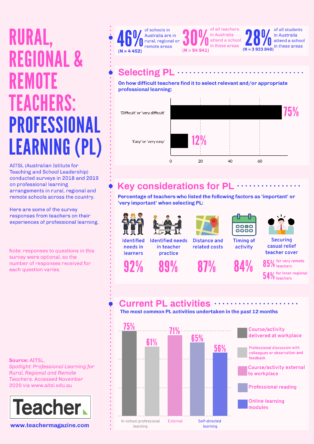Continuing teaching and learning from home throughout the pandemic has challenged educators in many ways and has increased their reliance on digital technology. This has extended to delivering and completing professional learning online.
A recent rapid review has identified 5 principles to inform the design and delivery of digital professional learning resources. The review was conducted by the Australian Council for Educational Research (ACER) to support Life Ed Australia’s Being Healthy, Being Active project.
Lead author of the rapid review, ACER Research Fellow Kashfee Ahmed, shares the review's findings in a recent article published in ACER’s Discover. She says the research team aimed to find out if the current online platforms available to teachers are meaningful, engaging and user-friendly, and which modes and formats of online resource delivery are most appropriate.
Five principles of effective professional learning
The 5 principles identified by the research team are: relevance, educational value, learning environment, social presence and quality content. The team also made one recommendation for each principle.
On relevance, Ashfee says: ‘We identified that the first principle in guiding the design of digital professional learning resources is that they must be relevant and meet teachers’ needs … the review recommends that teachers should be involved in the design, trial and evaluation of professional learning programs and resources.’
The next principle states that online professional learning must have educational value, which can be ensured by demonstrating that learning has occurred (through an assessment, for example). The learning environment should also be usable and flexible to suit the needs of teachers, Ashfee writes.
‘One recurring finding from the research is the value of social presence, or the extent to which a person feels socially connected to others in their online environment,’ she writes, explaining that the facilitator’s connection with participants has an impact on their outcomes.
Finally, the 5th principle outlines that quality content from a range of sources should be available for teachers. ‘The research also shows that the integrity of a resource is a critical component of its educational value and that its content must be reputable, current and accurate,’ she says.
In the article, Ahmed also shares a list of key success factors for the design and delivery of online professional learning.
To find out more about the 5 principles for effective online professional development and the success factors, read the full article: Five principles for effective online professional learning published in ACER’s Discover.
Related content
Last year, we brought you the details of the first stage of the Being Healthy, Being Active project which involved capturing how Australian students feel about the transition from primary to secondary school.
As a school leader, consider the professional learning your staff have completed online. Would you say the 5 principles described in this article were featured? Did you give staff the opportunity to give feedback on the elements they enjoyed about the design and delivery, and what could be improved?



